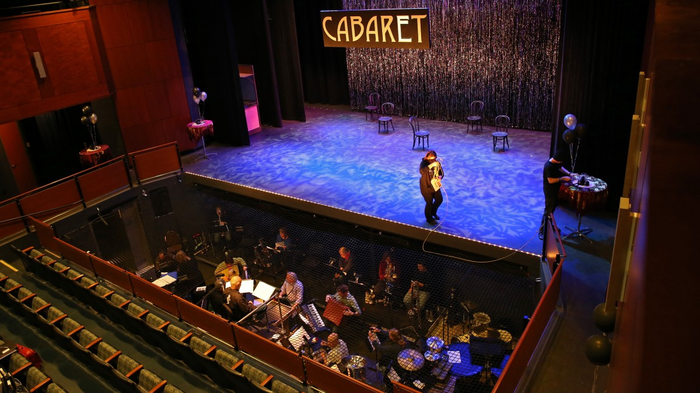Ghost Light – love letter or eulogy?
Helen Turner-Smyth has nothing but praise for this ‘poetic tribute’ to Scottish theatre past and present
Ghost Light (National Theatre of Scotland) premiered last month as part of the My Light Shines On Edinburgh International Festival. The piece, a 30 minute film featuring extracts from past NTS performances including works by writers J. M. Barrie, Kieran Hurley and Franz Kafka, has variously been described as a “celebration”, “love letter” and “poetic tribute”.
Its title refers to the single light bulb lit by the final person to exit a theatre and extinguished by the first to enter it, remaining onstage when the theatre is otherwise completely unoccupied, hence “ghost” light. According to Ghost Light’s description: “Its constant illumination represents the enduring spirit of theatre in these dark times”.
"This is not just another live stream"
While the creative feeling and technical skill behind Ghost Light are evident, what is perhaps most impressive watching the film is the skilful juxtaposition of its creatives’ grief at the current state of the national theatre sector with the evident resilience of their imagination and enterprise.
Many companies have chosen to make recordings of past performances available online, but the NTS takes this a step further – this is not just another live stream. Ghost Light blends extracts from a diverse selection of works, opening with David Greig’s adaptation of the childhood classic Peter Pan.
The camera follows the ghost light (now the familiar fairy companion Tinkerbell) into the wings, panning on to backstage where we see the weird figures of May Sumbwanyambe’s Ghosts of the Future. The extracts vary in genre, theme, style, and intended audience, ensuring that the tribute - the imaginative creation of Hope Dickenson Leach, Jackie Wylie and Philip Howard - reflects the diversity and vitality of theatre’s reach.
A number of the scenes resonate powerfully with contemporary politics and discourse. Backstage, the generic view through the camera becomes point of view. We follow a woman into a lift who proceeds to directly address the camera, invading its space and proximity; she reflects that she is “probably” a hero for writing an uncompromising passage about local council corruption in the latest draft of the script she carries.
The camera moves wordlessly and hastily away from her and down a corridor, only to whip back at the accusation that it is ignoring her monologue due to “a gender thing”. In fact, the camera work reflects the sense of violation felt by the audience from the shift in our relationship to the actors. The move from being invisible to earlier characters to being directly addressed deliberately creates a sense of unease through excessive self-awareness.
The exploitation of POV to present a shifting power dynamic continues into the next scene, which sees the camera catch the post-coital chit-chat between female actor and male cleaner. The voyeurism of this moment echoes an earlier character’s traumatic recollection: as a child, he and his father had walked in on his white nanny “Mary” having sex with a black man. Although his father had covered his eyes and mouth he “could still hear them in the darkness” and notes that his father just “stood there, watching”.
"The underlying sense of Ghost Light is one of eulogy"
The episodic shorts that constitute Ghost Light possess a range of tones from the serious and melodramatic to the more playful and comedic. In a further (more explicit) engagement with the themes of gender politics and inclusivity, an actor addresses an audience: “I see you madam, sir, they…” recognising that “we can’t go on” in the way we treat each other “even if some differences are better than others”.
Some light relief on the same theme towards the end of the piece is welcome; in one satiric sketch, in contrast to the sinister undertones of the above-mentioned scene, senior theatre manager “Sheila” complains that “you can’t walk two feet” in the National Theatre of Scotland “without falling over a fallopian tube”.
Yet the underlying sense of Ghost Light is one of eulogy. The film opens with a shot of an empty auditorium and concludes with a return to that stage without an audience, framing the whole piece with direct references to the mournful postponement of live performance.
The tour through foyers and dressing rooms, from line rehearsal and wardrobe change to managerial discussion, reminds us of the length of the creative theatrical process, as well as the multiplicity of roles involved in creation and staging. Through this we are reminded of the severity of the current pandemic’s effects, as well as the inevitable delay to returning productions to stage even when restrictions are lifted.
However, this love letter is also an entertaining, engaging justification of the eternal relevance and value of theatre as a part of society, its scenes combining elements from past musings on the nature of identity, nationality and society. Although it contains a variety of content, the smooth segues between scenes create a sense of continuity and accordance of these performances as part of a theatrical legacy, the creative power behind which may be diminished but will, inevitably, endure.
 News / Pembroke to convert listed office building into accom9 December 2025
News / Pembroke to convert listed office building into accom9 December 2025 Features / Searching for community in queer Cambridge10 December 2025
Features / Searching for community in queer Cambridge10 December 2025 News / Uni Scout and Guide Club affirms trans inclusion 12 December 2025
News / Uni Scout and Guide Club affirms trans inclusion 12 December 2025 News / Uni redundancy consultation ‘falls short of legal duties’, unions say6 December 2025
News / Uni redundancy consultation ‘falls short of legal duties’, unions say6 December 2025 News / Gov declares £31m bus investment for Cambridge8 December 2025
News / Gov declares £31m bus investment for Cambridge8 December 2025









